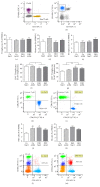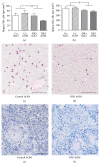Diet-Induced Obesity Is Associated with an Impaired NK Cell Function and an Increased Colon Cancer Incidence
- PMID: 28357137
- PMCID: PMC5357539
- DOI: 10.1155/2017/4297025
Diet-Induced Obesity Is Associated with an Impaired NK Cell Function and an Increased Colon Cancer Incidence
Abstract
Obesity is associated with an increased colon cancer incidence, but underlying mechanisms remained unclear. Previous studies showed altered Natural killer (NK) cell functions in obese individuals. Therefore, we studied the impact of an impaired NK cell functionality on the increased colon cancer risk in obesity. In vitro investigations demonstrated a decreased IFN-γ secretion and cytotoxicity of human NK cells against colon tumor cells after NK cell preincubation with the adipokine leptin. In addition, leptin incubation decreased the expression of activating NK cell receptors. In animal studies, colon cancer growth was induced by injection of azoxymethane (AOM) in normal weight and diet-induced obese rats. Body weight and visceral fat mass were increased in obese animals compared to normal weight rats. AOM-treated obese rats showed an increased quantity, size, and weight of colon tumors compared to the normal weight tumor group. Immunohistochemical analyses demonstrated a decreased number of NK cells in spleen and liver in obesity. Additionally, the expression levels of activating NK cell receptors were lower in spleen and liver of obese rats. The results show for the first time that the decreased number and impaired NK cell function may be one cause for the higher colon cancer risk in obesity.
Conflict of interest statement
The authors declare that there is no conflict of interests regarding the publication of this paper.
Figures







References
-
- WHO. Obesity and Overweight. Geneva, Switzerland: World Health Organisation; 2015. (WHO fact sheet N 311).
LinkOut - more resources
Full Text Sources
Other Literature Sources

